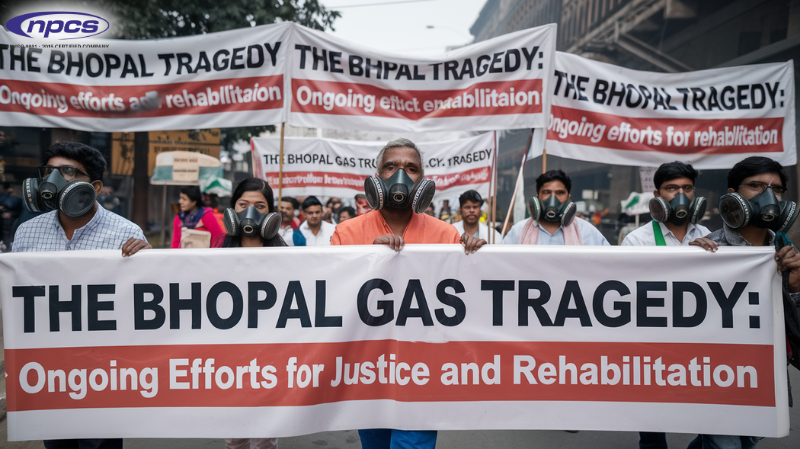Bhopal Gas Tragedy
The December 1984 Bhopal gas tragedy is one of the most terrible industrial disasters in the world’s history. And even after nearly four decades, the effects of the catastrophe are still experienced by the survivors and their families. The Indian government and many international bodies have been working tirelessly to serve justice and rehabilitation and compensation after such a catastrophe. Nonetheless, the rehabilitation is mainly complicated and difficult owing to the scale of the tragedy and even the delicate issues of health and environmental sustainability in the long term.
Background
On and around the night of 2nd to 3rd December, 1984, the city of Bhopal which is the state capital of Madhya Pradesh played host to one of the most disastrous industrial accidents ever to occur. A sudden, massive chemical leak occurred when methyl isocyanate (MIC) and other chemicals escaped from a Union Carbide India Limited (UCIL) factory that was concerned with the manufacture of pesticides. The yet undispersed gas cloud reached and enveloped many adjoining human habitats putting more than half a million persons at risk.
The immediate impact was horrendous. Nearly all who were able to escape the deadly air remained in hospital, oranges and other food were inhaled as well under the toxic gas, especially pregnant women. The official accounts began to suggest the death toll to be confined to the record of about 2,259 inhabitants within the ring city. It was several weeks and some months that the scale of the disaster dawned on these people. Gas exposures are estimated to have killed 15 000 to 20 000 persons over the years, and more than half a million people suffered from various debilitating effects of the exposure, such as respiratory diseases, eye problems, skin ailments and cancers. The disaster had physical effects on the victims that went beyond the obvious and led to deep emotional scars that persist to this day.
Ongoing Compensation Efforts
The Indian state has tirelessly advocated towards ensuring that survivors and the families of victims are well compensated. The scheme dealing with Bhopal Gas Leak Disaster (BGLD), which is under the Department of Chemicals and Petrochemicals, was established to cater for the rehabilitation as well as financial compensation of the victims. Every other year, the funds are provided to cater for settlement of pending compensation claims as well as new sicknesses caused by the gas leak health complications.
Going back to the financial year of 2022-23, the Indian government spent Rs. 23.08 crore on BGLD activities again, emphasizing the financial commitment towards victims’ issues. The Office of the Welfare Commissioner located in Bhopal is crucial in the payment of compensation fund and its management. It controls how the gas victim or victims’ families are assisted financially.
Compensations have been made in several occasions over the years. However, many victims claim that the compensations are not enough to take care of treatment expenses and loss of income. Other than that, there have been lawsuits in which the Indian government has sought additional damages from Union Carbide and its parent company Dow Chemicals.
Rehabilitation Challenges and Health Concerns
Despite the fact that compensation is one component of the response, providing long-term rehabilitation to the survivors emerges as a wider objective. Many of those who died during the gas attack suffer from other health conditions as well, such as lung fibrosis, cancer, reproductive health complications, and even birth defects for children of those parents affected by the gas exposure.
Most of the health systems created for the benefit of the survivors are still wanting. Most, if not all, of the hospitals that were built to cater for the health of the gas afflicted people, do not have the skills and facilities to heal the advanced health issues of the survivors which are very dynamic in nature. Even with all these factors in play, most of the survivors have reported issues regarding proper and timely medical interventions, which has led to their discontentment and feelings of neglect.
This, in addition to others, have forced serious problems. No doubt, there are serious risks associated with the toxic exposure. Environmental malaise caused by the manufacturing unit of UCIL is still relevant at this Moment. The industrial estate’s toxic waste has been mostly left in a state of undeclared emergency, percolating into the aquifer and endangering the health of living populations around it. Efforts to rehabilitate the area have been bogged down by red tape and court battles illustrating yet another challenge for the people of Bhopal.
Corporate Accountability and Legal Struggles
Corporate responsibility has become a river that runs through the Bhopal gas tragedy. The Union Carbide corporation was heavily criticized not solely because of the devastation caused by the factory, which it commissioned. After the explosion incident occurred, the firm tried to reduce all the responsibility explaining legal aspects and giving what a lot of people considered to be a minor amount of money to the affected parties.
In the year 1989, the Union Carbide Corporation came to an understanding with the Indian authorities, in which the former undertook to compensate the victims with worth $470 million. However many felt this opinion was too modest in light of the magnitude of the disaster. Additionally, the Nepali government has been trying to sue Dow Chemical for additional damages after purchasing Union Carbide in 2001 but the gauntlet of legal battles has been a long and arduous process.
Activists and the affected persons in the course of time have agitated for improvement. In the legal regime on the scenes of industrial carnage. The Bhopal tragedy has contributed to the international discourse on corporate social responsibility. Arguing for the need for improvement of the industrial practices in the low risk. And more importantly, the high risk industries.
Environmental and Social Impact
The catastrophic gas leak at Bhopal also accounts for irrevocable environmental degradation. Moreover, there are signs of waste residues and toxic materials emanating from the defunct. UCIL plant watering down certain soil and water bodies. Many researches have found groundwater, used by thousands of people. To be extremely contaminated which poses more danger in health to them most especially through that water.
That remedial measures for the restoration of the environment have been delayed. And residents of the affected regions constantly live in potential danger of harmful chemicals. They have also not settled on the detailed scheme to rehabilitate the polluted area which has left the environment in continuous deterioration. This pollution has come to epitomize social neglect and zeal to serve the ends of businesses. Without regard to the communities’ well-behaved policies
Lessons Learned
Bhopal gas tragedy brought to focus the pathetic state of industrial safety norms. As well as the strategies of industrial emergency management. After this tragedy, many changes happened in India, for example, the Environment Protection Act. It main purpose was to enhance industrial safety in India, was passed in 1986. These regulations provided a higher degree of control over dangerous industries and required implementation of safety systems.
The Bhopal catastrophe taught a different lesson as well regarding corporate responsibility. That disaster became the embodiment of an extreme case where disregard for safety. The sake of profits could cause deleterious effects on humanity. In the following decades, however, international society, through NGOs, many, even corporations. It has been making more and more pressure in order to ensure that those who engage in mass production do not do it in such a way.
Looking Ahead
Then, She went on to inform the gathered people, that the people did not only remember the victims long after the Bhopal gas tragedy. But also remember the lessons learnt that were a disappointment to them. However, much has a lot to do even today vis-a-vis the government of India and the world. The health and the well being of the environment are also a subject of concern to the people. They have already become victims of this disaster and justice has not yet been achieved.
The commitment to make temporary interventions for the relief of victims through expendable resources. Over a long period of time is also exhibited by the government. Nevertheless, justice can only be restored when all the issues of health and environmental. They concerns are dealt with and those that caused the problem are made to answer. The Bhopal Gas Tragedy reminds people of the need to be safe from more industrial catastrophes. The dangers of such facilities to people’s health and the safety of the industries’ surrounding communities.
Conclusion
The Bhopal Gas Tragedy is one of the most catastrophic industrial accidents in the history of mankind. It able to cause irreversible changes to the lives of hundreds of thousands of people. While attempts to compensate and assist the survivors. Their families are ongoing, the fight for justice was long and arduous. It is a tragedy whose impact has extended beyond mere death rates. It has reformed occupational health and safety laws, principles of corporate social responsibility, and environmental policies across the globe.
Even after almost 40 years have passed, memories of that night remain with the people. As a malignant instance of what corporations, nations, or societies owe to the defenseless. While the works of offering justice, rehabilitation and settlement of Bhopal survivors go on. This tragedy will always determine the course of global industrial practice in the future.
Note: If you have any questions related to opening any manufacturing business , contact us Niir.org
Read related blogs: Npcs blog






